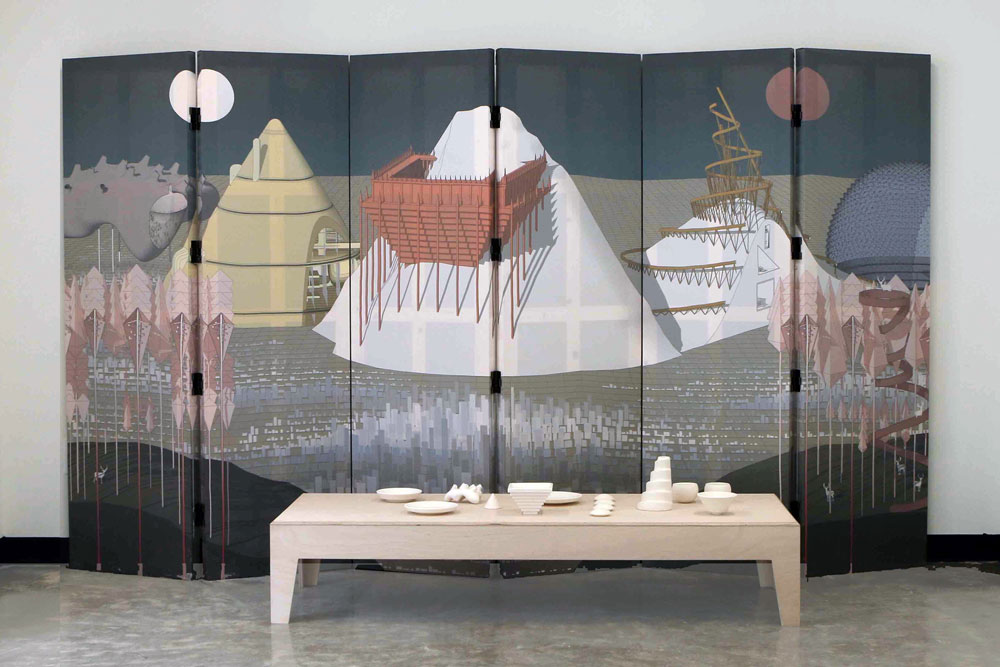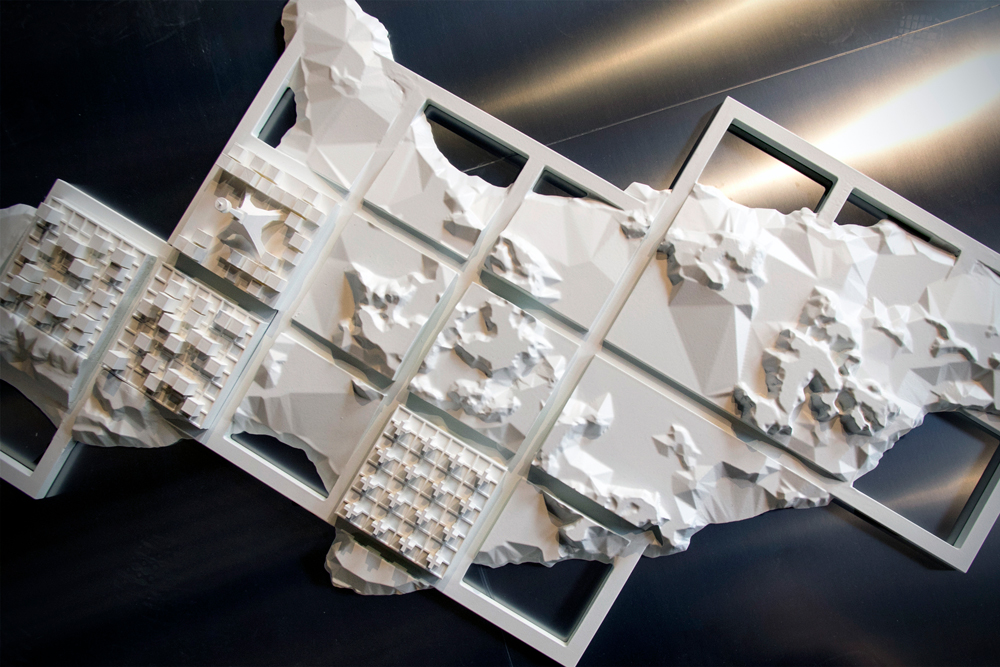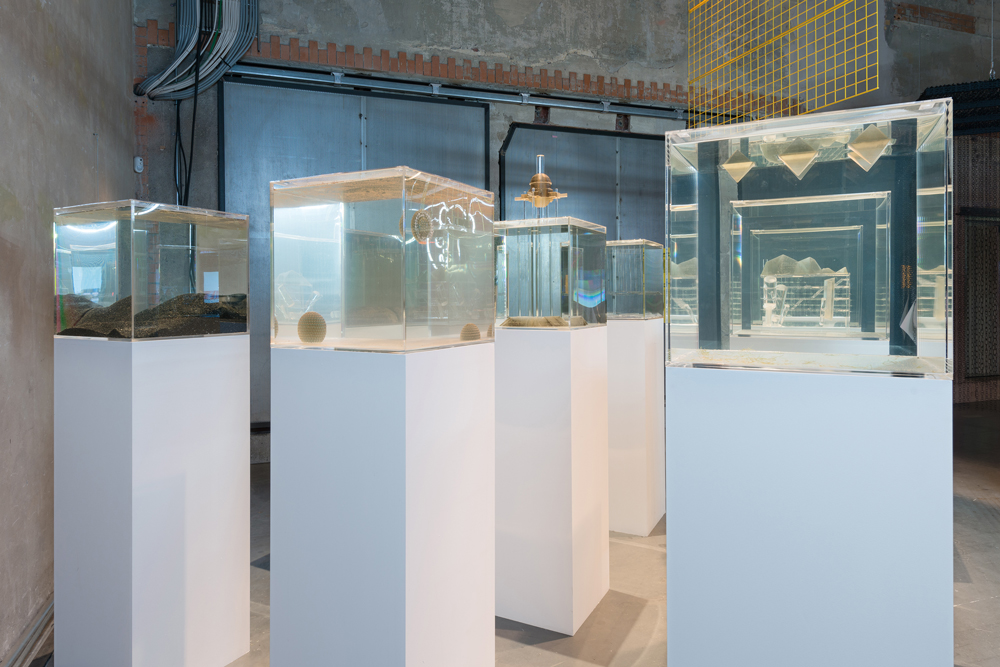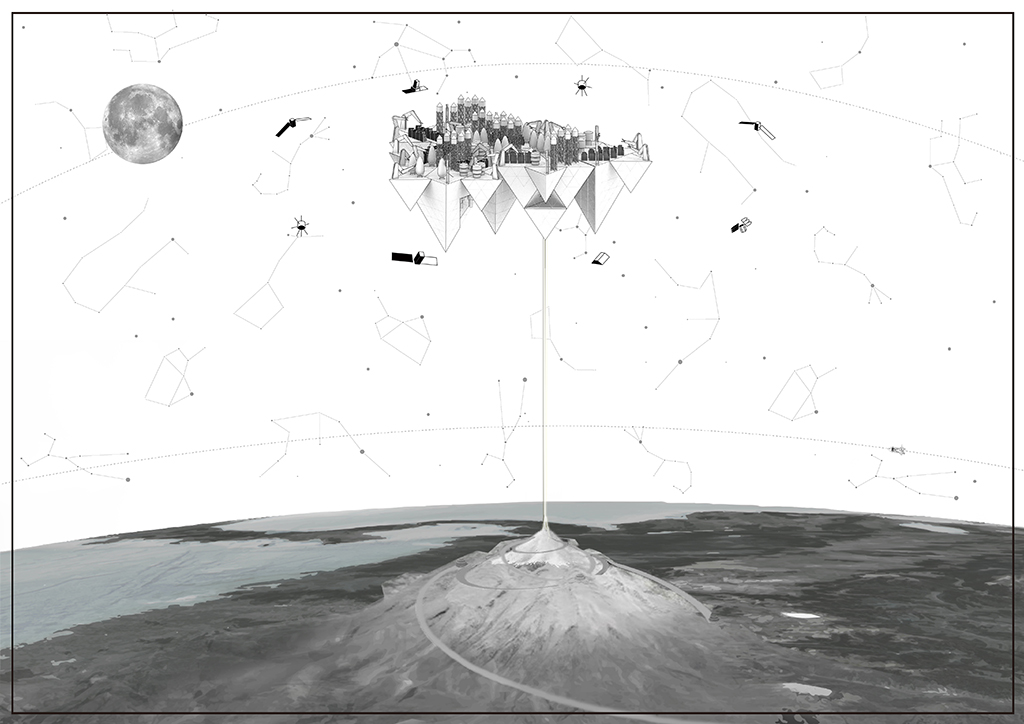Suspend disgust at the thought of trash; make it a compelling subject for designers and the broader public. That’s Rania Ghosn’s tactic for getting more people to improve our built environment and ask the necessary questions about landfills, oil rigs, space debris and other unpleasant externalities. Ghosn, assistant professor of Architecture and Urbanism at MIT School of Architecture + Planning and founding partner of DESIGN EARTH, says, “Maybe aesthetics can have the capacity to change the way we perceive systems and the value we ascribe to them.” After all, she points out, climate change is both a physical and a cultural crisis.
DESIGN EARTH is a collaborative practice led by Ghosn and El Hadi Jazairy, assistant professor of architecture at the University of Michigan and research scientist at the MIT Norman B. Leventhal Center for Advanced Urbanism. Established in 2010, Design Earth explores the geographies of technological systems, such as those of energy, trash and water.
DESIGN EARTH is one of seven exhibitors commissioned to create work for Dimensions of Citizenship, the exhibition that will represent the United States in the US Pavilion at the 2018 Venice Architecture Biennale. Four of their large-scale drawing projects—After Oil, Of Oil and Ice, Pacific Aquarium and Trash Peaks—will be on view at Cooper Union in “Geostories: Another Architecture for the Environment” from October 17 through December 2, 2017.
Ghosn also received a Fay Chandler Faculty Creativity Seed Grant from the MIT Center for Art, Science & Technology (CAST) to create the installation Blue Marble Circus for Design Biennial Boston 2017, on view along the Rose Kennedy Greenway through October 8, 2017. This grant, established in memory of the artist and philanthropist Fay Chandler, supports creative projects by MIT faculty that will come to fruition within a year of the award.
In this interview, Ghosn speaks with CAST about her practice and several of DESIGN EARTH’s recent projects, including Blue Marble Circus.
A CONVERSATION WITH RANIA GHOSN
What ideas and works led to Blue Marble Circus?
In our practice DESIGN EARTH, El Hadi Jazairy and I have been doing a series of projects that probe environmental questions with the tools of architecture. We used mostly drawing formats for a series of Biennale projects: After Oil for the Kuwait Pavilion at the Venice Biennale, Pacific Aquarium for the Oslo Architecture Triennale, Of Oil and Ice for the Sharjah Biennial and Trash Peaks for the Seoul Bienniale.
It’s a series of works that we refer to collectively as “geostories.” The series addresses architectural representation—in particular, architectural drawings—to make visible larger technological systems and the way they change the environment and to speculate on their future. We need to accept that we’ve created these technological landscapes—landfills, oil rigs and so forth—that have changed the Earth in a significant way. The projects operate at the limit of comfort in that possibility or speculation.
From the drawings, we segued into a series of objects. They are somewhere between an artifact and an architectural model, but we also hope that they will resonate in the popular imagination beyond the discipline of architecture. Blue Marble Circus is the first of the series—or the largest of these miniature projects. And in this case, it’s a one-tenth miniature of the Pantheon. The desire is similar to other projects: How can we, through that presence on the Greenway, get people to think of these large transformations of the Earth?

The Pantheon is one of many cultural or formal references in the work. Could you talk about these multiple references and the layering of meaning in your work?
Blue Marble Circus speaks to two important things. One is the image of the Earth as blue marble, how much we tie that image to the rise of the environmental movement and what it says about looking at the Earth from far away and as rather fragile. And the other is the typology of the circus, which we understand to be a series of rather fantastic performances that edge on the grotesque and evoke a certain reaction in the public. It’s in that juxtaposition that we started to think of how architecture relates to how we imagine the Earth.
We started from a specific building, the Pantheon, which is often described as a house for all gods, but also as an architecture of the cosmos. We loved how that building inscribes within it, in section, a full sphere. That’s how it’s organized geometrically. But the sphere is not necessarily visible. So the project aspired to give form to that sphere. And that form is that of the blue marble.
Yet, its materiality is very distinct. It’s no longer what we associate with pristine nature. It’s made of foam. It’s wrapped in plastic. Its materials speak to an Earth that has been fully transformed by the industries of fossil fuels or petrochemicals. And maybe there’s a need to deal with this plasticity and permanent transformation of the Earth.
The object also has an eye, which operates like a pinhole or a peep show. When you put your head into the camera obscura, you see reflections of the surroundings in the interior of the sphere. So what looks like a smooth sphere on the outside is actually a series of polygons in the inside.
The Pantheon is, of course, a departure point; Blue Marble Circus also references the sphere on the shoulders of Atlas, the very early representations of the world, which often took the form of a circle and projections, and famous architectural buildings, especially in the period of French Revolutionary architecture. The piece even flirts with the images of the atomic bomb tests, which in their formal language are very similar.
Multiple references are often present in DESIGN EARTH projects; ours is not a tabula rasa imagination. We are not presenting a vision of the newness of something that’s never existed. We are actually capitalizing on existing references and using a snowball effect of the imagination.
In your classroom, how do you address visual literacy? I imagine architecture students are fairly sophisticated in this respect.
There are two courses in which this methodology has had a direct impact at MIT. One is an elective that I’ve developed called Landscapes of Energy, which asks students to think of a particular technological system, that of energy, through a specific material deployment. They have to start from a project. And they have to start from the representations of this project—drawing maps and sections and looking at photographs—to understand how it’s presented.
They don’t start from an abstract idea of energy security or energy independence, because ideas can quickly become ideologies, which close thinking. If instead you start from physical space and understand how the cultural, political, symbolic and historical dimensions are always overlaid in one particular spatial condition, and if you begin to represent those, then you can unpack the multiple layers of what a technological decision means and how it impacts space. So it starts from that.
Similarly, in the Architecture Thesis Prep course that I’ve been teaching, we do not begin with an intellectual or verbal exercise before working with a representation or images. Rather, students are invited to deploy representation from day one. The first time I taught it, I asked students to design the panorama of their project on the first day. Then I asked them to emphasize different attributes of sections in order to understand that relationship to the Earth at specific moments, rather than from above. So there’s a very specific representational language that becomes important.
How did you become focused on works that are driven by aesthetics, rather than purely utilitarian purposes? Does the term “speculative design” apply to your work? If not, is there a more apt term?
Speculative would probably be a good umbrella term. There’s a whole wave of speculative aesthetics that are in the world now. From some of what I have read about it, I don’t know if I am fully in that grain. I’m probably more inclined to think about the capacity of architecture to project. I mean, we always talk about architecture projects. That projective capacity is important, so maybe “projective.”
These projects are a representation of the political and economic structures that regulate the specific technologies or scales of the Earth. For example, Neck of the Moon responds to a provocation of space debris in the geostationary orbit of the Earth. That’s a concern that occupies scientists, who are working on a series of proposals. There are actually aerospace engineers at MIT developing techniques to deal with space debris.
Neck of the Moon makes visible that geostationary orbit of satellites—where you don’t need any fuel power to keep them running, just pure gravity. Although few people on Earth think about it, this spot is a desired area. It’s already crowded. And we don’t recover many of the things that we’ve put out there. A number of abandoned satellites pose a concern for us, because if we want to put more out there, or if we want to navigate that space, we might hit them one day.
DESIGN EARTH aims to speak to the scale of environmental transformation of the Earth so we can clear that geostationary orbit. Can we clean it? There is often an action/reaction response to technology. Bruno Latour, a French philosopher of science and technology who’s always an inspiration, draws on this metaphor of Frankenstein’s monster; the monster was not born a monster. He became a monster once his creator abandoned him in the lab. It seems that that’s what we do with our technologies.
In 1950, when oil was first discovered, corporations, the United Nations and the public alike were all super thrilled about the possibility that oil would bring democracy to the developing and the developed world alike. It’s a matter of a few decades until you realize the pitfalls and the shortcomings of any technology. You start to speculate about the next technology, associate negative things with the existing technology, and hope that the next one will only bring solutions.
What we try to do through our work is say, well, you have to start to design with the footprint of what we’ve created, with the technologies that we’re living with, rather than just wipe it clean and hope that whatever is new is going to be much better and without trouble, because of course, it won’t be. So aesthetics is the language. It’s the way of architecture being part of these broad cultural conversations on the environment.






